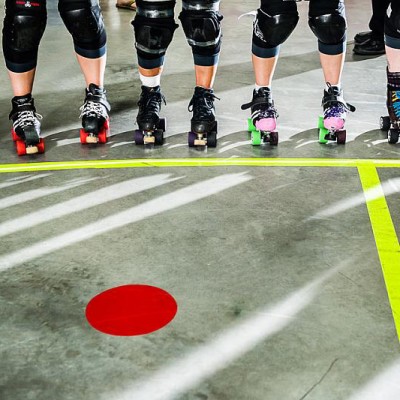
Happy New Year everyone! The New Year marks a new beginning: a perfect time to reflect on the past and plan for the year ahead. As roller derby season is about to kick off for most of you, this is a great time to reflect on what you want to achieve!
In the next two posts, I will breakdown how goal setting can impact your mental game, how to develop effective goals, and tips to make your goals stick.
What Is Goal Setting?
Goal setting is not a new concept. Many of you have set goals for yourself- especially around this time of year! Goals allow us to narrow in on the objectives we want to achieve. Mental performance is about strengthening our mental game, which is done by increasing and improving key mental skills. Skills can include focus, communication, self-awareness, emotion control, etc. In order to improve these mental skills, we need to use performance enhancing strategies (or methods) that will allow us to practice and develop these skills. Goal setting is one of the most used and most powerful performance enhancement strategies.
How Can Goal Setting Improve My Mental Game?
When you set objective goals for yourself, you’re outlining the direction that you need to take. The process of creating goals provides you with an opportunity to reflect on your performance and, more importantly, forces you to narrow your attention on the elements of your performance that need to be developed.
I like to use a maze as a metaphor when dealing with goal setting. I want you to picture a very difficult maze. The starting point of the maze is where You’re now. The end point of the maze are the goals you wish to achieve.
- With Goals: As soon as you step foot into the maze (your season), you’re trying to move into the direction that will bring you closer to exit (your goals).
- Without Goals: You’re entering the maze (your season) without any direction. You’re just walking around. If you’re lucky, you might find the exit (or accomplish a desire). Otherwise you’re just wandering aimlessly.
Goal setting is a great way to build up athletic confidence. With goals, you will be able to see your progress and accomplishments. Let’s picture that maze again.
- With Goals: As soon as you get out of the maze (reached your goal), you will feel a sense of satisfaction knowing that you were able to step up to the challenge. Even if you don’t make it out of the maze (unable to achieve a goal), you should have a sense a pride that you could make your way closer to the exit.
- Without Goals: You never planned to accomplish an objective. Meaning, you don’t have a plan to make it to the exit. If you do accomplish that feat, it will feel more like a fluke than an achievement. That being said, you could have made progress in the maze, but without knowing where the exit is located you will never know how far you’ve come.
SMART Goals
These types of goals are objective: Specific and based on a concrete element within your environment. In order for objective goals to be SMART goals they need to be Specific, Measurable, Achievable, Relevant, and Time bounded.
S… Specific means exactly that! Avoid setting goals that are too general or too vague. “I want to be a stronger blocker” is too vague. Narrow in on specifically what you want to achieve. “I want to improve my individual positional blocking skills”.
M… Having goals that are measurable allows you to track your progress. “I want to get lead jammer status 60% of the time per game” or “I want to be able to positional hold back a jammer for 20 seconds”.
A… When setting goals, you need to make sure that your goals are challenging, but at the same time you need to make sure that the goals are achievable. If your goals are unattainable, it could lead to frustration.
R… You need to make sure that all your goals are relevant, and that they’re helping you move closer to your long-term goal.
T… Time: for you to be accountable to your goals, you need to set a date (month/year) when you intend on completing them. Example: “By mid-season (May 2017) I will improve my positional blocking skills to be able to maintain contact on the jammer for 20 seconds”.
Let’s Start Climbing the Mountain
You know how a goal should be written, now it’s time to start thinking about what you’d like to achieve this season. Picture yourself at the bottom of a large mountain you want to climb. The flag on the peak of the mountain represent your Dream Goal.
It’s important to have a dream. Dreams give us passion and fuel our drive to push through challenges. Your dream goal is an outcome goal. As you might have figured out, outcome goals are based on an end result. Examples might include making it onto a travel team or your team making it to the D2 playoffs.
Now, I’d like you to think about your Dream Goal and write it down. Make sure it’s a SMART Goal.
Remember that the flag is not part of the mountain. You can make your way to the peak and never touch the flag. This is why you need to set a Long-Term Performance Goal, which is represented by the peak of the mountain. Ideally if you reach these long-term performance goals it will bring you closer to reaching your dream goal. Performance goals focus on achieving standards based on your previous performances: such as “By July 2017 I will get 2 penalties or less per game”. These types of goals move away from outcomes and focus on what can you do!
Now I want you to think, what do I need to change or improve in my performance that will get me closer to my Dream Goal? Write down 3 long-term performance goals.
For example: if your dream goal is to be selected onto a travel team as a jammer by May 2017, maybe a long-term performance goal could be “I will get lead jammer status more than 50% per game by May 2017”.
Take the time to reflect on your Dream Goal and your Long-term Performance Goals. You want to be passionate about these goals! Write down these goals on paper. In the next mental muscle post we will continue with setting our goals!

 Fresh Meat – You Got This!
Fresh Meat – You Got This!  How to Improve at Derby’s 27 Laps Test
How to Improve at Derby’s 27 Laps Test  The Top Ten Exercises for Roller Derby Athletes
The Top Ten Exercises for Roller Derby Athletes  Go From Benchwarmer to MVP with the 1% Secret
Go From Benchwarmer to MVP with the 1% Secret  Pre-Hab: How to Engage Your Core
Pre-Hab: How to Engage Your Core